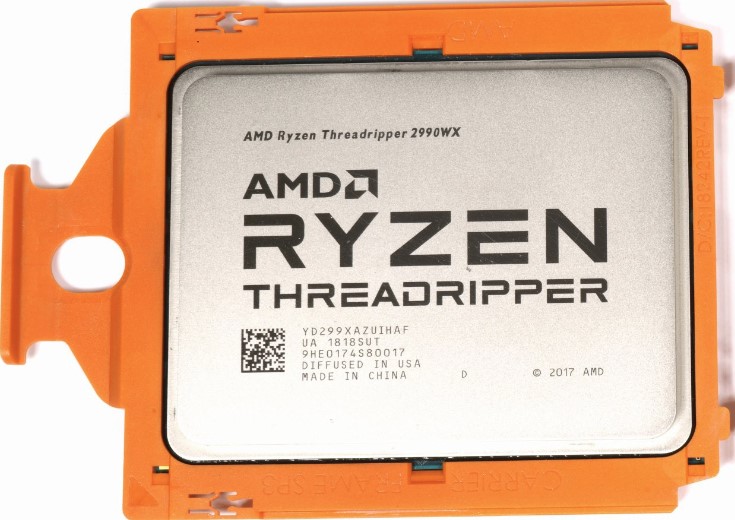Core Combat: Intel Xeon W-3175X vs. AMD Threadripper 2990WX
AMD's Threadripper 2990WX redefined the high end desktop when it burst onto the scene with 32-cores and 64-threads, setting a new high watermark for sheer multi-threaded performance. Threadripper's copious core counts, low pricing and a healthy slathering of 64 PCIe lanes made the platform a hit with the prosumer and workstation crowd, threatening Intel's dominance in the high-end workstation market.
Intel, not content with second place, kicked the tires on its aging Skylake architecture and rolled out a new overclockable workstation processor that hails from the server space. The 28-core 56-thread Xeon W-3175X also comes to market bearing a six-channel memory controller and support for ECC memory, a must for professional-class workloads. Overclocking is also on the table, but the high-end focus is apparent in its $2,999 price tag.
The Xeon W line of processors are designed specifically for workstation users and their unique needs, so we put both processors through our test suite to see which one comes out on top for professionals. Here's how they stack up.
Features
AMD's Threadripper processors excel at heavily multi-threaded workloads thanks to their high core counts. Due to the Threadripper 2990WX's unique design, the extra cores come at the cost of memory throughput and single-threaded performance. As a general rule, CPU clock speeds decrease as core counts grow. As such, the Ryzen Threadripper 2990WX’s base clock is only 3GHz, 500MHz less than then 16-core AMD Ryzen Threadripper 2950X. AMD also limited the maximum boost clock to 4.2GHz.
The Threadripper 2990WX is built in a quad-die layout, which is effectively two dual-die Threadripper 2950X processors tied together into one multi-chip module. Unfortunately, the design doesn’t allow all four dies to communicate directly with memory controllers, which limits the performance of the second half of the processor on certain memory-intensive tasks. An unoptimized Windows scheduler only complicates matters. AMD does offer several different toggles to optimize performance for certain tasks, but those require a reboot after each adjustment. The company has also developed a new Dynamic Local Mode, which is a background process that automatically tunes the processor for certain applications, but results also vary based upon the application.
AMD’s Threadripper 2990WX supports corruption-preventing error-correcting code (ECC) memory, but that requires certification from the motherboard vendor, and qualified support is spotty. Intel restricts ECC support to its Xeon-class processor lineup to differentiate its enthusiast-class processors from its enterprise- and workstation-class products. Given its workstation focus, motherboards for Intel's Xeon W-3175X come with full ECC support.
AMD’s processors also natively accept DDR4-2933, whereas Intel’s platform is officially limited to DDR4-2666. While Threadripper holds the advantage of faster native memory support, Intel's Xeon W-3175X comes with a six-channel memory controller that offers more throughput than Threadripper's quad-channel configuration (~59GB/s vs. ~35 GB/s).
Get Tom's Hardware's best news and in-depth reviews, straight to your inbox.
The W-3175X also supports Intel's vPro management suite, which simplifies remote management, diagnosis and updating tasks for IT professionals. The processor also comes with RAS (Reliability, Availability, Serviceability) features designed to ensure steady operation if the processor encounters corruption in the memory or logic arrays.
| CPU | Intel Xeon W-3175X | Ryzen Threadripper 2990WX |
| Socket | LGA 3647 | TR4 |
| Cores / Threads | 28 / 56 | 32 / 64 |
| TDP | 255W | 250W |
| Base Frequency | 3.1 GHz | 3.0 GHz |
| Max Boost Frequency | 4.3 (Turbo Boost 2.0) | 4.2 GHz (Precision Boost Overdrive) |
| L3 Cache | 38.5MB | 64MB |
| Integrated Graphics | No | No |
| Graphics Base/Turbo (MHz) | N/A | N/A |
| Memory Support | DDR4-2666 (ECC) | DDR4-2933 (Varies) |
| Memory Controller | Six-Channel | Quad-Channel |
| Unlocked Multiplier | Yes | Yes |
| PCIe Lanes | 48 | 64 (Four to the chipset) |
| Architecture | Skylake-X | Zen+ |
Intel’s Xeon W-3175X is built on a refresh of the company’s Skylake architecture. The new processor features 28 physical cores and 56 logical threads, setting a new high bar for Intel's W-series processors. Unlike Intel's latest high end desktop models, the W-3175X doesn't come with Solder Thermal Interface Material (sTIM), which improves heat dissipation. Intel uses standard pTIM (polymer TIM) instead, so dissipating heat from the die to the heatspreader could be troublesome. However, we found that the large heatspreader helps avoid many of the pitfalls, at least with standard cooling solutions.
| Active Cores - Non-AVX Frequency | Base | 1 -2 | 3 - 4 | 5 - 12 | 13 - 16 | 17 - 18 | 19 - 20 | 21 - 24 | 25 - 28 |
| Xeon W-3175X | 3.1 | 4.3 | 4.1 | 4.0 | 4.0 | 4.0 | 4.0 | 4.0 | 3.8 |
| Xeon Platinum Scalable 8180 | 2.1 | 3.6 | 3.4 | 3.3 | 3.3 | 3.1 | 3.1 | 2.9 | 2.8 |
The W-3175X boosts to different clock speeds depending on the number of cores in use, as outlined in the chart above. The Xeon W-3175X is merely a respin of Intel's Platinum Scalable 8180, but as you can see, the 3175X comes with much higher Turbo Boost 2.0 frequencies.
AMD holds the PCIe lane advantage with 60 native lanes exposed to the user, while Intel exposes 48 total lanes. AMD's extra lanes are useful for professionals that load up fast NVMe storage arrays, multiple GPUs, and/or high-speed networking adapters.
Winner: Intel.
As reflected by its feature set, the Xeon W-3175X is specifically designed for workstations. The processor supports vPro management and RAS features that simply aren't present with Threadripper 2990WX, while also guaranteeing certified support for ECC memory on supporting motherboards. The processor also consists of a single large die and mesh architecture that delivers consistent memory latency and throughput. Pairing the consistent memory performance with the superior throughput of a six-channel memory arrangement could yield big gains for some professional applications.
Overclocking
Conventional wisdom says that if you’re building a workstation-class PC for mission-critical tasks, you really shouldn’t be overclocking your processor. However, some professionals with particularly demanding workloads, like financial traders, are willing to push the limits. In fact, overclocking was a key advantage for Threadripper against Intel's Xeon W lineup, which used to feature locked multipliers on all models. The easy overclocking afforded by the Threadripper processors probably played a hand in Intel's decision to bring an overclockable Xeon W to market.
If overclocking is what you’re after, Intel’s platform can hit higher maximum clock speeds: We reached 4.6 GHz with relative ease on a beefy EKWB 360mm AIO cooler, and thermals were the limiting factor. That means that custom loops or more extreme cooling solutions, like chillers, could expose even more frequency headroom. AMD presses its silicon near the limits of its capabilities at stock settings, so there often isn't much overclocking headroom. That trend doesn’t change with the high-end Threadripper lineup.
Like AMD’s other Zen/Zen+ processors, the Threadripper 2990WX features the company’s Precision Boost Overdrive (PBO) technology, which dynamically adjusts the CPUs parameters to match the current workload and power delivery environment. In our experience, it does a better job at maintaining a good balance of higher single- and multi-core boost frequencies than manually overclocking. Think of it as an automated overclocking feature that will extract the most performance possible from the silicon given the capabilities of your motherboard, cooler and power supply.
PBO brings what was once the dark art of overclocking high core-count processors down to the layman. Most workstation users aren't known for their overclocking prowess, so having a program that automatically pushes the limits of the processor and supporting components is a tangible advantage.
In most of our test suite, Intel’s Xeon W-3175X at stock clocks outperforms our overclocked Threadripper 2990WX. But the W-3175X requires much more expertise to reach the CPU's highest overclocking potential because you're still stuck with manual tuning in either the motherboard firmware or inside Intel's eXtreme Tuning Utility (XTU) software. You can overclock the chip to higher frequencies, but you'll be restricted by your cooling solution. You'll also need high-end components, like a top-notch power supply, motherboard, and cooler to push the limits of the silicon.
Winner: Tie
Intel’s Xeon W-3175X will push higher than a Threadripper processor, but you'll have to invest heavily for the extra performance. Plan to spend copious amounts of money on premium components to unlock the best the silicon has to offer.
Threadripper 2990WX's overclocking headroom isn't nearly as high, but you'll be able to squeeze out gains in several areas without resorting to exotic cooling solutions. Also, don't underestimate the advantages of AMD's PBO, an automated overclocking feature that makes extreme tuning a one-click solution.
Cooling Requirements
Both Intel and AMD enable overclocking on their top-of-the-line processors, but keeping these CPUs cool is no easy task–especially once you start cranking up the voltage. Don’t expect an off-the-shelf air cooler to keep the temperatures in line on either chip under heavy workloads if you push the chip beyond the stock settings.
Our Intel Xeon W-3175X was stable at 4.6GHz with an EKWB EK-Phoenix 360 Annihilator cooler, which is surprisingly higher than the 4.4 GHz we squeezed out of the Core i9-9980XE. If you’re serious about overclocking Intel’s W-3175X, plan to build a custom water-cooling loop or invest in a ultra-high-end AIO water cooler to expel the heat efficiently. The W-3175X overwhelmed our cooler before we reached the maximum overclock, so more exotic solutions, like chillers, will unleash even more performance.
AMD’s Ryzen Threadripper 2990WX doesn’t produce as much heat as Intel’s flagship Xeon W processor when overclocked, but you should still spring for a liquid-cooling system to keep the temperatures in check. In our tests, we managed to run the Threadripper 2990WX with an oversized air cooler, and we even enabled AMD Power Boost Overdrive (PBO). But the fan had to spin at full speed to keep up, which made for a noisy computing environment.
We had good results with a Corsair H115i dual-fan closed-loop cooler with AMD's top chip, but we would still recommend a custom loop if you plan to push a Threadripper 2990WX to its limits for extended periods.
Winner: AMD.
Intel recommends liquid cooling as a minimum requirement for stock operation of the Xeon W-3175X. Meanwhile, AMD recommends an air cooler for its Threadripper 2990WX. You can get away with an air cooler for the Threadripper 2990WX, but better coolers can extract higher overclocks.
Motherboard Options
AMD’s Ryzen Threadripper processors drop into X399-based motherboards with a TR4 CPU socket. X399 motherboards often come equipped with four 16x/8x PCIe slots with support for 4-way SLI and Crossfire setups, high-end audio, Wi-Fi, network adapters and multiple m.2 ports. X399 motherboards are usually well equipped for overclocking with high-quality MOSFETs, VRMs, and capacitors and a high level of copper content in the circuitry. In short, Threadripper motherboards are among the best available, but they carry price tags that match their feature sets. Budget options begin at $240, while some high-end models retail for up to $780.
AMD released the X399 chipset alongside the first-generation Ryzen Threadripper processors, and all first-generation motherboards support the second-generation Threadripper processors.
Intel recently split its server chips out onto their own platform with a larger interface and a different chipset. However, the first round of Xeon Ws, which span from four to 18 cores, drop into the LGA 2066 socket we know from the company's high-end desktop motherboards. To bring the W-3175X to workstations, Intel transitioned the LGA 3647 socket that it had used exclusively for server products to new motherboards with the C620-series chipset.
Your selection of C620 motherboards is extremely limited: For now, there are only two motherboards available. Both ASUS and Gigabyte models feature support for two power supplies to feed enough power to the 255W Xeon W-3175X for overclocking. The motherboards also come in the EEB form factor, which measures 14" x 14", meaning you'll also need a high-end chassis to house the motherboard.
As we expect from motherboards designed for the extreme high end of performance, these models come with all the extras, and then some. The ASUS ROG Dominus Extreme, for instance, comes with a 32-phase power delivery subsystem, 10G LAN, wireless AC support, RGB lighting and a large OLED panel for monitoring. All of these features contribute to the highest pricing we've seen for a motherboard. The ASUS ROG Dominus Extreme weighs in at $1,799 at retail. Pricing for Gigabyte's AX1-C621 hasn't been announced yet, though we expect it to land within a similar range.
Of course, these prices will restrict the number of customers interested in building systems with these ultra-high-end LGA3647 motherboards, but we expect that cheaper models will come to market in the future. As we noted in our review, we were able to overclock our liquid-cooled system with a single power supply easily. Intel tells us that the second power supply is really only needed for pushing the edge for waterchillers and LN2 cooling, so it makes sense that motherboard vendors will eventually come out with motherboards that only support one PSU, thus lowering prices tremendously. For now, though, LGA 3647 motherboards are by far the most expensive on the market.
Winner: AMD.
AMD's X399 motherboards are pricey, but boards that support the Xeon W-3175X set a new high bar, relegating them to the extreme high-end of the market. This premium equates to much higher-priced OEM systems, and custom builds will be far more expensive than systems built around the Threadripper platform.
Workstation Performance:
The SPECworkstation 3 benchmark is designed to measure workstation performance in professional applications. The full suite consists of more than 30 applications, but we've winnowed down the list to eight tests that focus specifically on CPU performance.










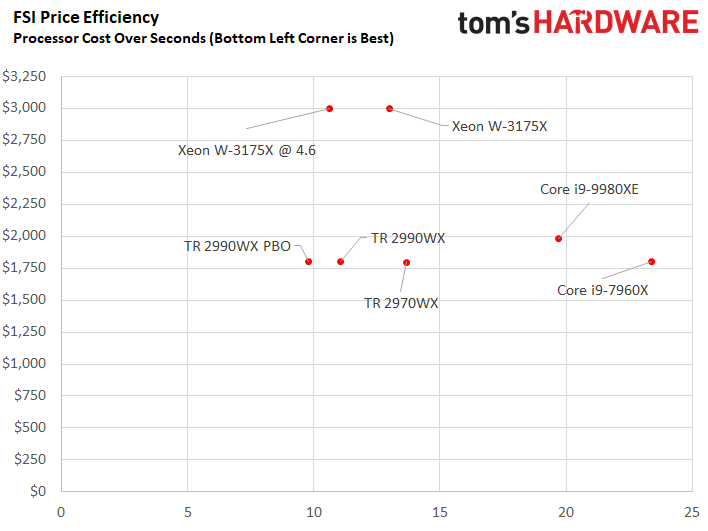
These workloads focus on performance in complex workloads, like financial forecasting models, seismic processing, three-dimensional structural computations, molecular dynamics, and discrete energy minimization.
AMD's Threadripper 2990WX is competitive at stock settings and takes the lead in the Monte Carlo and NAMD workloads, but the Xeon W-3175X serves up the most well-rounded performance profile across the span of our tests. In some tests, like Rodina LifeSciences, Kirchoff Migration, and Calculix, the Threadripper 2990WX provides an excellent price-to-performance ratio, especially when we consider its lower overall platform costs.
Winner: Tie.
Intel's Xeon W-3175X takes the overall performance crown, but the Threadripper 2990WX's great price-to-performance ratio is hard to ignore. Ultimately most workstation customers make decisions based upon performance and price in very specific applications, so the winner really depends upon the intended use-case.
Gaming Performance
We'll be blunt here: If you’re just looking for a gaming CPU, you should probably look elsewhere. These chips are just too expensive to be worthwhile for gamers. Even if you have money to burn, an Intel Core i9-9900K is objectively the better option than either a Xeon W-3175X or a Ryzen Threadripper 2990WX. But if you need one of these CPUs for productivity reasons, it doesn’t hurt to know that when the workday is over, you can enjoy some high-performance gaming.
Both CPUs in this showdown are suitable for gaming, but Intel’s Xeon W-3175X does hold the advantage due to its higher single- and multi-core clock speeds.




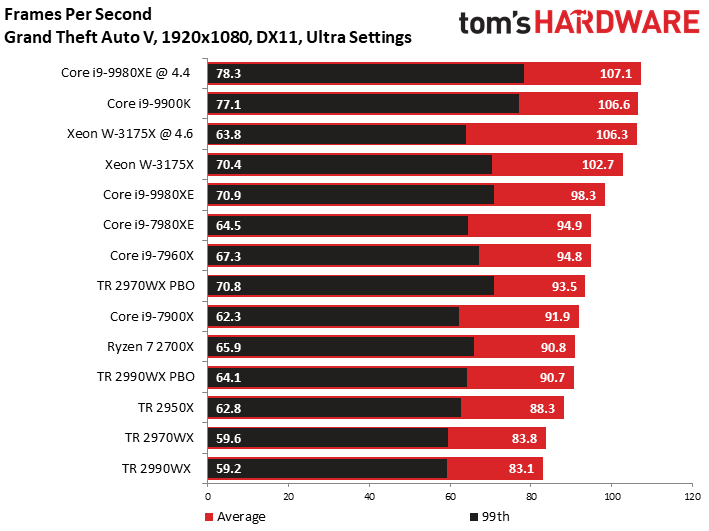





[Note that we didn't re-publish our full gaming test results here. For all our gaming results between the Xeon W-3175X and the Ryzen Threadripper 2990WX, see our full review of the Xeon W-3175X.]
AMD’s Ryzen Threadripper 2990WX isn’t as powerful as Intel’s flagship CPU in gaming workloads at sub-4K resolutions, but it’s certainly capable of running games well. Keep in mind that once you start raising your gaming resolutions above 1080p, these performance differences tend to shrink as the GPU becomes the bottleneck. When gaming at 4K with the same high-end graphics card, frame rates between the Intel and AMD CPUs here tend to be about the same.
In either case, the Xeon W-3175X comes out on top, but you'll pay a handsome premium for what equates to an ~11 FPS gain in average framerates.
Winner: Intel.
The Xeon W-3175X is much faster than AMD’s Threadripper 2990WX for gaming workloads, but if you buy one of these CPUs just for gaming, you’re missing the point -- and wasting your money.
Productivity Performance
High-core count processors traditionally aren’t the most efficient option for most lightly-threaded office productivity tasks, but Intel has made strides in this area with the W-3175X.







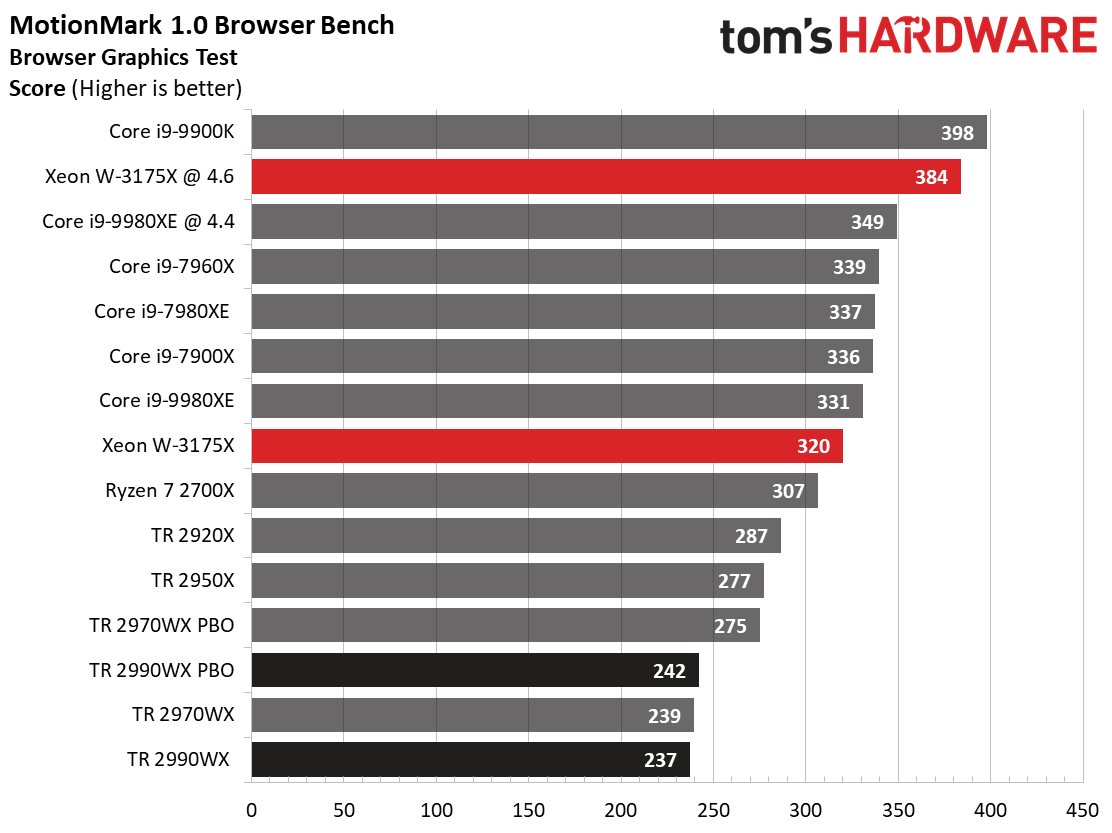

Intel’s Xeon W-3175X consistently outpaces AMD’s Threadripper 2990WX in Adobe’s Creative Cloud suite, but lower-cost mainstream processors are much more agile in these types of lightly-threaded tasks.
Intel's processor is also surprisingly strong in our web browsing tests, including Kraken JavaScript Benchmark, WebXPRT and MotionMark 1.0, while AMD’s Threadripper 2990WX lands at the bottom of the pack.
Winner: Intel.
The Xeon W-3175X benefits from its higher clock speeds and instruction-per-cycle throughput advantage, which translates to faster performance in mundane office-class workloads. That said, if lightweight office work is your primary use for your computer, there are other more-affordable options (from Intel or AMD) that would be a better choice.
Rendering
Threadripper 2990WX's extra cores endow the processor with more performance in heavily multi-threaded workloads, but Intel's mesh architecture and single-die approach provides superior performance in many workloads, especially after tuning.






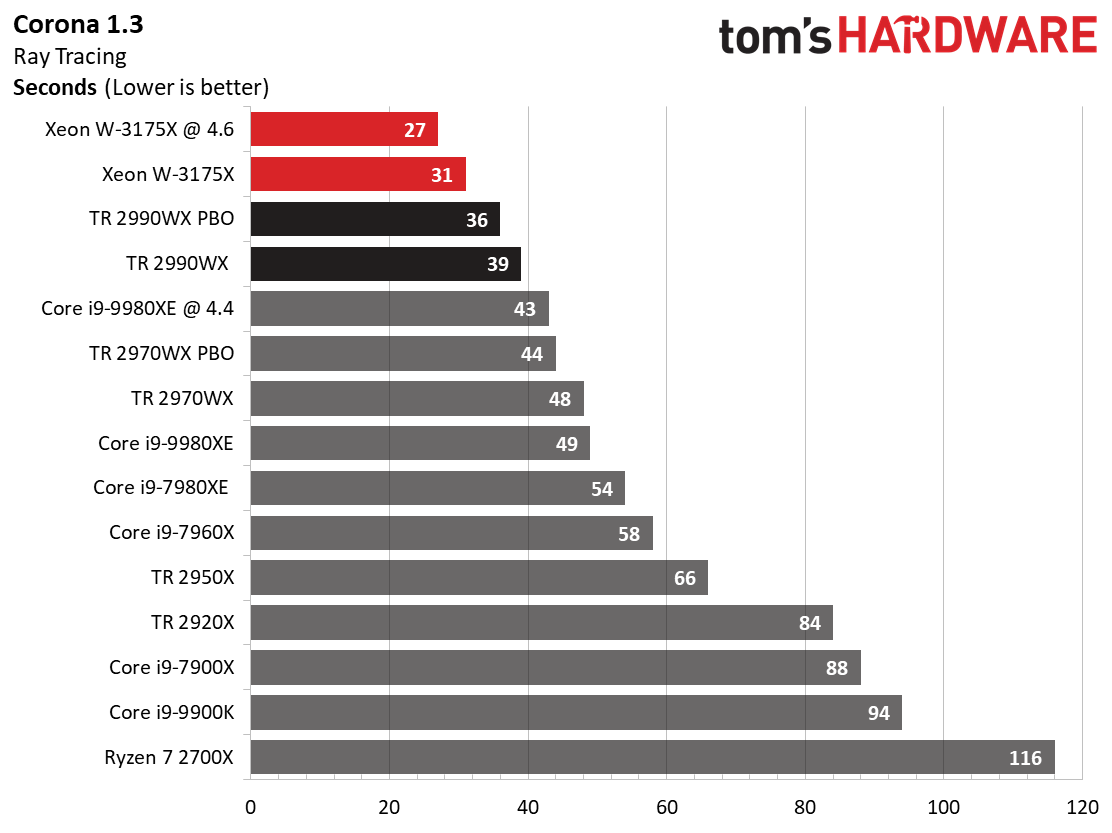




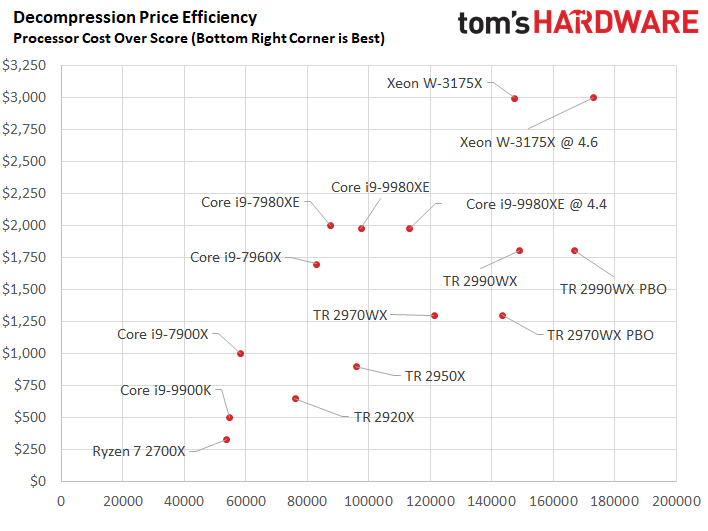
Our rendering test split into both single- and multi-threaded categories. With a single core active, we see that Intel's Xeon W-3175X trounces Threadripper 2990WX by a big margin, highlighting the chip's beastly single-core turbo boost.
The multi-threaded tests are the best indicator of performance in most rendering applications, which often exploit the parallelism of multi-core designs to the fullest. Loading up all the cores naturally plays into the hands of the 2900WX with its superior core count, making its scores much more competitive with Intel's flagship.
Intel's W-3175X still leads in the majority of multi-core workloads, but the performance deltas shrink to the point that Intel's 66% price premium doesn't represent the best return on the additional investment. For instance, the W-3175X is only 20% faster during the Corona ray tracing rendering workload, which represents its largest advantage. More often than not, that advantage shrinks to 10% or below in heavily-threaded rendering applications.
Intel also pulls off the win in the marketing war with a ~5% advantage in the Cinebench application that AMD often uses in its marketing materials and demos. But, again, we're looking at a relatively slim advantage that comes at a significantly higher price point for the chip, not to mention the extreme accommodations you'll need for the W-3175X
Winner: AMD.
AMD’s Threadripper 2990WX delivers ultra-competitive performance in rendering applications, but at a much cheaper price point than Intel. And that's before we take the Xeon W-3175X's expensive accommodations into account.
Encoding & Compression
AMD’s 2990WX is far more effective when it can unleash the full heft of its 64 threads, but Intel's inherent per-core performance advantage favors video and audio encoding. For professionals, time equates directly to money, and the W-3175X delivers a big advantage for encoding over Threadripper.


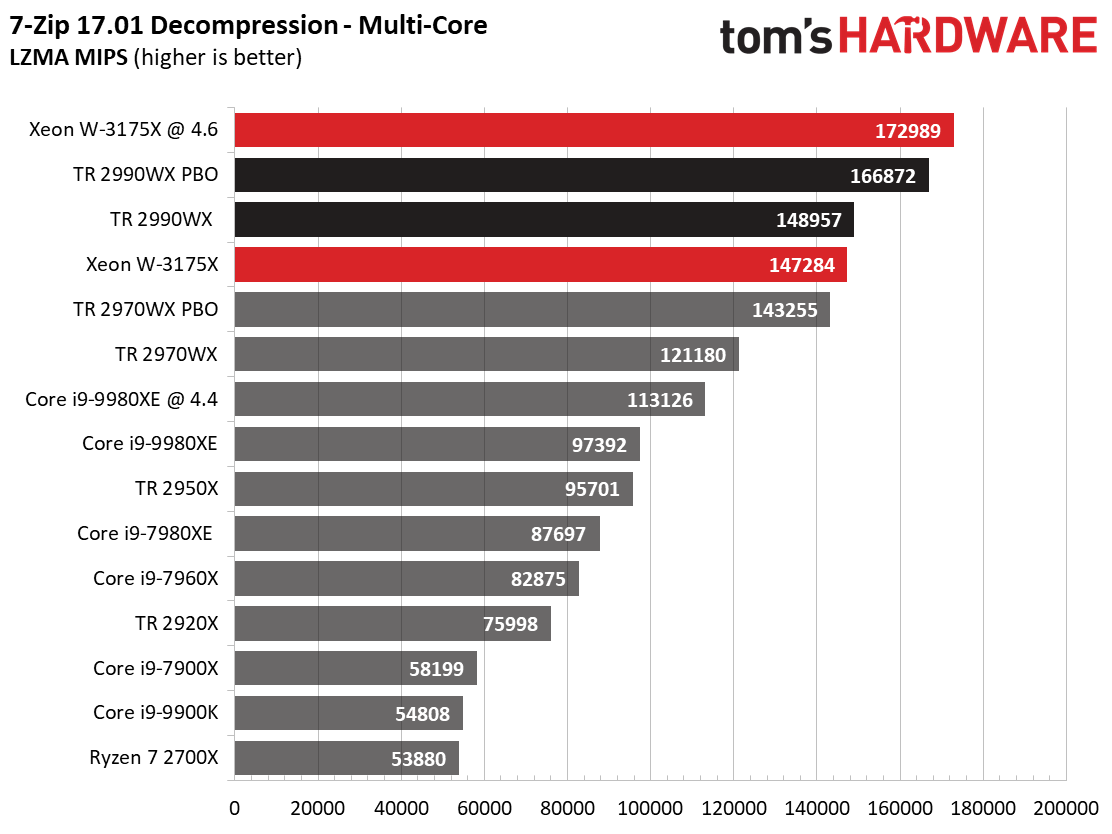

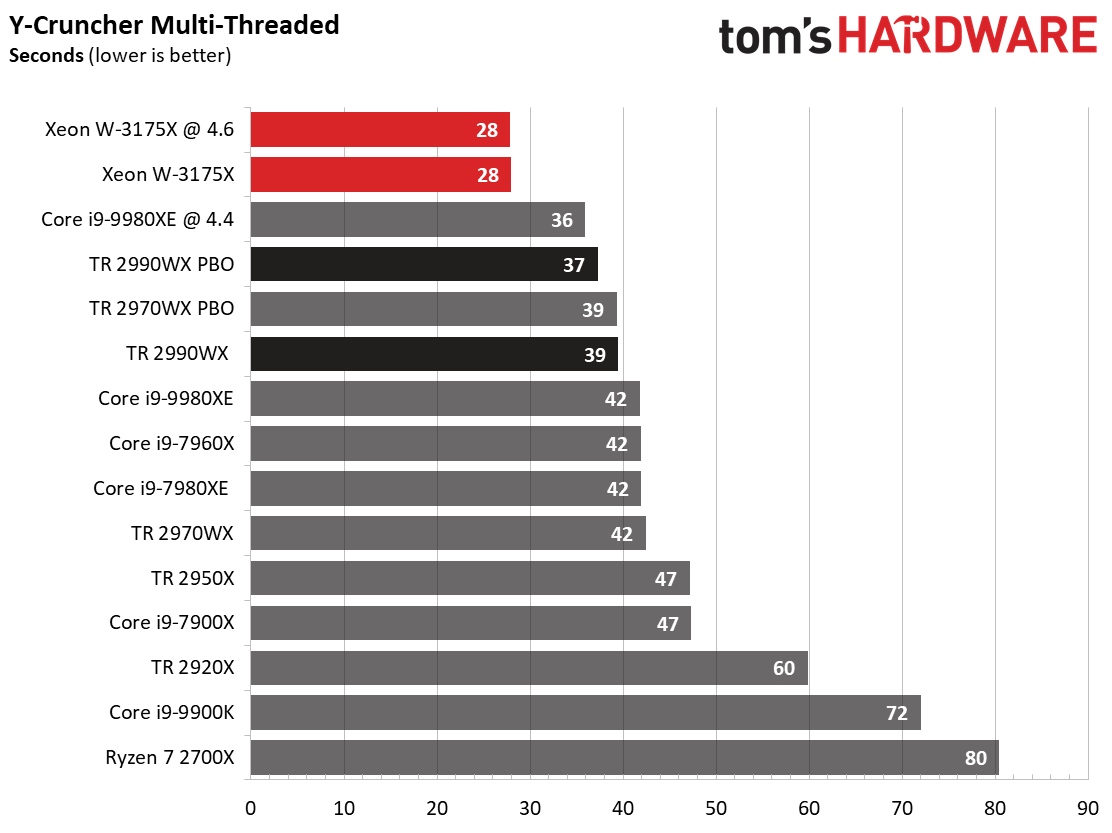


The W-3175X is much more effective in applications that leverage the AVX instruction set, as seen in our y-cruncher (an AVX-heavy program that computes pi) results. Those advantages also show up in other AVX-enabled applications, like Handbrake. At stock settings, the W-3175X nearly halved the time required to convert a 4.19GB video file to MP4 using x264 and x265.
The Threadripper 2990WX suffers in some workloads, such as multi-core compression, due to memory bandwidth limitations and software/operating systems that aren't designed to accommodate the unique architecture.
Winner: Intel.
AVX instructions boost the performance of many professional applications, and pairing Intel's superior AVX implementation with its per-core performance advantage gives it the edge in tasks that don’t scale well across many computational threads.
Value Proposition
This equation appears to be pretty simple for professionals: time equates to money, and predictable performance in a wide range of workloads is a must. However, that reality doesn't grant the Intel Xeon W-3175X the value advantage for all applications.
Intel's Xeon W-3175X comes with a steep price tag of $2,999, but that's actually a decent deal given that this processor is merely an optimized version of the company's top-end Xeon Platinum Scalable 8180 that retails for $10,000. The price of the processor is competitive given its performance, but then you have to calculate in the exorbitant costs of the motherboards that support the processor (and the requisite chassis), memory to populate the six channels, an extremely expensive cooler (the low-end models starts at $399), and a beefy power supply. In fact, you'll need two power supplies if you plan on overclocking with an extreme cooling solution.
Socket TR4 motherboards that support the Threadripper 2990WX are expensive by the normal standards we associate with an HEDT platform, but they are tame in comparison to LGA3647 boards for the W-3175X. You're still on the hook for a capable cooler, but AMD's platform is compatible with a wide range of mainstream cooling solutions, which lowers cost and broadens options. Overall, you'll pay less for the Threadripper 2990WX and the supporting platforms.
Winner: AMD.
The Threadripper 2990WX’s 32 cores and 64 threads make it an incredible bargain, even with a $1,700+ price tag. Whip in the excessive costs of every single supporting piece of hardware for the Xeon W-3175X, and the choice is clear: AMD's Threadripper 2990WX is the value winner.
Bottom Line
First and foremost, workstation-class processors aren't designed to deliver the best performance in gaming and other mundane desktop PC applications, so if gaming is your primary mission, you're best served with a mainstream desktop processor, like the Core i7-9700K or Ryzen 7 2700X. These platforms are even suitable for streaming at most bit rates, but even streamers stepping up to the next tier are better served with a Core i9-9900K or entry-level Threadripper platform.
Intel's Xeon W-3175X and AMD's Threadripper 2990WX are highly specialized processors developed for niche markets, so your mileage will vary based upon your workload. Intel's Xeon W-3175X excels in the broadest spate of workloads due to its balanced mix of single- and multi-threaded performance, but platform costs are ultimately the processor's Achilles heel. Given its strong and predictable performance, the W-3175X itself is competitively priced at $2,999, but it requires a host of exotic components to extract the utmost performance.
You'll need to factor in an ultra-expensive LGA3647 motherboard, of which there are only two available, and a similarly rare and expensive cooling solution to deal with the W-3175X's 255W of thermal output. You'll also have to select a high-quality power supply to power the system, and if you step up to a more exotic cooling solution, you're actually on the hook for two power supplies.
In contrast, the Threadripper 2990WX has an incredibly competitive price-to-performance ratio in many heavily-threaded tasks. The 2990WX isn't the performance leader in lightly-threaded applications, like gaming and office applications, but it still delivers an acceptable level of performance. The 2990WX also requires high-quality accommodations to unlock its full potential, but the platform has the advantage of a far wider selection of components, like motherboard and coolers, that are a fraction of the price compared to a W-3175X system.
You could likely build two Threadripper 2990WX systems for the price of a single Xeon W-3175X workstation, but workload scalability, performance density requirements in some environments, and extra software licensing fees blur the value proposition from that type of arrangement, meaning an actual overall price advantage would depend upon the specific use-case.
Unfortunately, the 2990WX does suffer some erratic tendencies borne of its unique architecture and an unoptimized Windows scheduler, so it’s best to select it for very specific workloads that can leverage its incredible compute resources. AMD does provide different modes to tailor the processor for different workloads, but the requisite reboots and frequent adjustments won't be tenable for professionals with established workflows that require several diverse types of applications. In other words, you'll have to pick your spots wisely.
Meanwhile, the W-3175X is more of a general workhorse that excels at nearly everything, but you'll pay a pretty penny for that predictable performance while the Threadripper 2990WX slots in as an attractive alternative.
Overall Winner: Tie.
| Round | Intel Xeon W-3175X | AMD Ryzen Threadripper 2990WX |
| Features | ✗ | Row 1 - Cell 2 |
| Overclocking | ✗ | ✗ |
| Cooling Requirements | Row 3 - Cell 1 | ✗ |
| Motherboards | Row 4 - Cell 1 | ✗ |
| Workstation Performance | ✗ | ✗ |
| Gaming Performance | ✗ | Row 6 - Cell 2 |
| Productivity Performance | ✗ | Row 7 - Cell 2 |
| Rendering | Row 8 - Cell 1 | ✗ |
| Encoding & Compression | ✗ | Row 9 - Cell 2 |
| Value | Row 10 - Cell 1 | ✗ |
| Total | 6 | 6 |
More Face Offs
- AMD Athlon 200GE vs. Intel Pentium Gold G5400: Cheap CPU Showdown
- AMD X470 vs Intel Z390: High-End Platforms Square Off
- AMD Ryzen Threadripper 2990WX vs. Intel Core i9-9980XE: Which HEDT CPU Is Best?
- AMD Ryzen 7 2700X vs Intel Core i7-9700K: Which CPU Is Better?
- AMD Ryzen 2 vs. Intel 9th Gen Core: Which CPU Deserves Your Money?
- AMD Ryzen 2 vs. Intel Coffee Lake: What's the Best CPU Platform?
- AMD vs. Intel: Which PC Build is Better for Under $500

Paul Alcorn is the Editor-in-Chief for Tom's Hardware US. He also writes news and reviews on CPUs, storage, and enterprise hardware.
-
redgarl Do we really need a gaming performance segment for such a product review? Nobody is going to play on a 28-32 core CPU... especially since AMD mentioned WX were NOT aimed at gamers.Reply
As far as features go... how Intel is winning when the only advantage it has is six-channel memory over AMD socket? 64 PCIe lanes, 64mb of L3 cache, 2933 MHz memory, 32 cores, lower temps and better power... -
redgarl Reply21752791 said:"an unoptimized Windows scheduler"
nuff said.
It is way more than this. We don't even have proper benchmarks to provide a good analysis.
As of now, Phoronix is the only person who provided a good idea to what to expect of a 32 core workstation, because he was using Linux.
Microsoft needs to wake-up.
-
Art_8_ When you know what Windows kernel is doing to the Threadripper and you run this comparison with anything other than an attitude of tongue in cheek you are complacent in spreading a load of bull. It is well known that the scheduler was modified by MS at the request of Intel to solve an Intel processor issue and MS went ahead with it even though as a collateral outcome it crippled the Threadripper.Reply -
AndrewJacksonZA Paul, for real, how many of these benchmarks can you run on Linux in order to mitigate the Windows scheduler issue, please?Reply
While I am a Windows user and all of my & my team's current use cases all fall on Windows software except for two which can run on Linux, but don't (yet?) there are many people who are not in that situation.
Also, seriously, gaming benchmarks?? -
A Stoner Just because you are not going to buy a 28 or 32 core processor for playing games does not in and of itself mean that gaming performance is not important.Reply
If I were going to dump $8000 to $12000 on a computer for rendering for example, I would not want to have to turn around and drop another $3000 to $4000 on a gaming computer. -
mischon123 Love to have a Threadripper. But right now life is good. 8 Ryzen cores already make this the best computing platform ever. Everything zips. No delays, stoppages, no weird bugs. Just happy.Reply
Those chips show whats ahead once they solve the bottlenecks, integrate ram and better graphics near the cores. I guess we will have 128 cores/128mb Ram/128gb graphics pipeline in a while. 2,4,6,16,24/32/64/128 in 2025? -
Paul Alcorn Reply21752949 said:Paul, for real, how many of these benchmarks can you run on Linux in order to mitigate the Windows scheduler issue, please?
While I am a Windows user and all of my & my team's current use cases all fall on Windows software except for two which can run on Linux, but don't (yet?) there are many people who are not in that situation.
Also, seriously, gaming benchmarks??
Running Linux isn't an issue, but spinning up benchmarks for multiple chips is a time consuming endeavor. Windows is the predominant OS for workstations, whereas we use Linux for server testing.
Yes, we run games. We do not deviate from our standard test regimen on any chip. This is because some might think we are hiding poor performance, etc, for the device under test. However, we will add tests to reflect specialized use cases, such as the workstation tests above.
-
tyns78 Performance per dollar is a different category from performance; to claim AMD ties or beats Intel in some categories b/c it's cheaper is disingenuous. Have performance comparisons, then have value comparisons.Reply
Intel smokes AMD's product, period. You'll always have to pay much more for the best hardware. -
WINTERLORD a amd motherboard is way cheaper then the MB that fit the intel chip plus cost of chip amdd wins this assuming the performance is close to same. although for just an ordanary high end machine iv always loved intel however they got some serios compatetion hereReply









